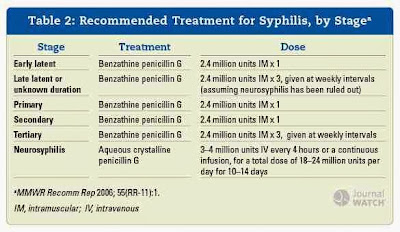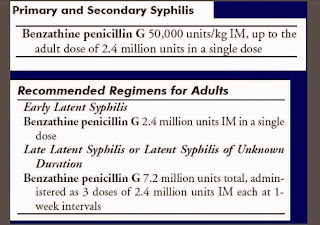syphilis prevention and treatment
Treatment
Early infections
The first-choice treatment for uncomplicated syphilis remains a single dose of intramuscular benzathine penicillin G or a single dose of oral azithromycin. Doxycycline and tetracycline are alternative choices; however, due to the risk of birth defects these are not recommended for pregnant women. Antibiotic resistance has developed to a number of agents, including macrolides, clindamycin, and rifampin. Ceftriaxone, a third-generation cephalosporin antibiotic, may be as effective as penicillin-based treatment. It is recommended that a treated person avoid sex until the sores are healed.
Late infections
For neurosyphilis, due to the poor penetration of penicillin G into the central nervous system, those affected are recommended to be given large doses of intravenous penicillin for a minimum of 10 days. If a person is allergic, ceftriaxone may be used or penicillin desensitization attempted. Other late presentations may be treated with once-weekly intramuscular penicillin G for three weeks. If allergic, as in the case of early disease, doxycycline or tetracycline may be used, albeit for a longer duration. Treatment at this stage limits further progression, but has only slight effect on damage which has already occurred.Jarisch-Herxheimer reaction
One of the potential side effects of treatment is the Jarisch-Herxheimer reaction. It frequently starts within one hour and lasts for 24 hours, with symptoms of fever, muscles pains, headache, and tachycardia. It is caused by cytokines released by the immune system in response to lipoproteins released from rupturing syphilis bacteria.Prevention
As of 2010, there is no vaccine effective for prevention. Abstinence from intimate physical contact with an infected person is effective at reducing the transmission of syphilis, as is the proper use of a latex condom. Condom use, however, does not completely eliminate the risk. Thus, the Centers for Disease Control and Prevention recommends a long-term, mutually monogamous relationship with an uninfected partner and the avoidance of substances such as alcohol and other drugs that increase risky sexual behavior.Congenital syphilis in the newborn can be prevented by screening mothers during early pregnancy and treating those who are infected. The United States Preventive Services Task Force (USPSTF) strongly recommends universal screening of all pregnant women, while the World Health Organization recommends all women be tested at their first antenatal visit and again in the third trimester. If they are positive, they recommend their partners also be treated. Congenital syphilis is, however, still common in the developing world, as many women do not receive antenatal care at all, and the antenatal care others do receive does not include screening,and it still occasionally occurs in the developed world, as those most likely to acquire syphilis (through drug use, etc.) are least likely to receive care during pregnancy. A number of measures to increase access to testing appear effective at reducing rates of congenital syphilis in low- to middle-income countries.

Syphilis is a notifiable disease in many countries, including Canada the European Union, and the United States. This means health care providers are required to notify public health authorities, which will then ideally provide partner notification to the person's partners. Physicians may also encourage patients to send their partners to seek care. The CDC recommends sexually active men who have sex with men are tested at least yearly.
References
- Hogben, M (1 April 2007). "Partner notification for sexually transmitted diseases". Clinical infectious diseases: an official publication of the Infectious Diseases Society of America. 44 Suppl 3: S160–74. doi:10.1086/511429. PMID 17342669.
- "Trends in Sexually Transmitted Diseases in the United States: 2009 National Data for Gonorrhea, Chlamydia and Syphilis". Centers for Disease Control and Prevention. 22 November 2010. Retrieved 3 August 2011.
- David N. Gilbert, Robert C. Moellering, George M. Eliopoulos. The Sanford guide to antimicrobial therapy 2011 (41st ed.). Sperryville, VA: Antimicrobial Therapy. p. 22. ISBN 978-1-930808-65-2.
- Radolf, JD; Lukehart SA (editors) (2006). Pathogenic Treponema: Molecular and Cellular Biology. Caister Academic Press. ISBN 1-904455-10-7.
- "Disease and injury country estimates". World Health Organization (WHO). 2004. Retrieved 11 November 2009.
- Lozano, R (15 December 2012). "Global and regional mortality from 235 causes of death for 20 age groups in 1990 and 2010: a systematic analysis for the Global Burden of Disease Study 2010.". Lancet 380 (9859): 2095–128. doi:10.1016/S0140-6736(12)61728-0. PMID 23245604.
- "Trends in Reportable Sexually Transmitted Diseases in the United States, 2007". Centers for Disease Control and Prevention (CDC). 13 January 2009. Retrieved 2 August 2011.
- "STD Trends in the United States: 2010 National Data for Gonorrhea, Chlamydia, and Syphilis". Centers for Disease Control and Prevention (CDC). 22 November 2010. Retrieved 20 November 2011.
- Kent, ME; Romanelli, F (February 2008). "Reexamining syphilis: an update on epidemiology, clinical manifestations, and management". Annals of Pharmacotherapy 42 (2): 226–36. doi:10.1345/aph.1K086. PMID 18212261.
- Ficarra, G; Carlos, R (September 2009). "Syphilis: The Renaissance of an Old Disease with Oral Implications". Head and neck pathology 3 (3): 195–206. doi:10.1007/s12105-009-0127-0. PMC 2811633. PMID 20596972.
- The Metropolitan Museum of Art Bulletin, Summer 2007, pp. 55–56.
- Rothschild, BM (15 May 2005). "History of syphilis". Clinical infectious diseases: an official publication of the Infectious Diseases Society of America 40 (10): 1454–63. doi:10.1086/429626. PMID 15844068.





































0 comments:
Post a Comment